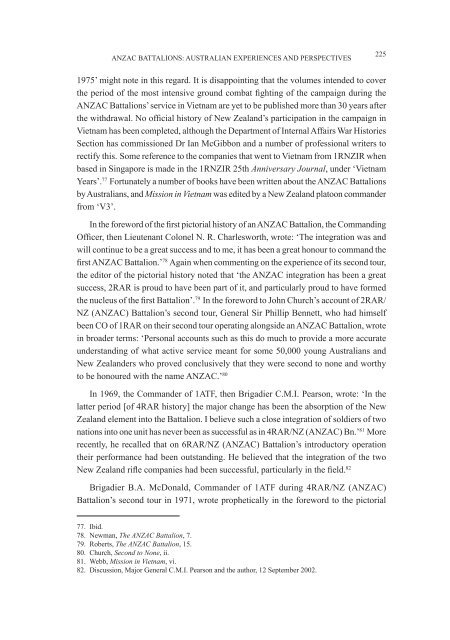conference proceedings - Australian Army
conference proceedings - Australian Army
conference proceedings - Australian Army
You also want an ePaper? Increase the reach of your titles
YUMPU automatically turns print PDFs into web optimized ePapers that Google loves.
ANZAC BATTALIONS: AUSTRALIAN ExPERIENCES AND PERSPECTIVES<br />
1975’ might note in this regard. It is disappointing that the volumes intended to cover<br />
the period of the most intensive ground combat fighting of the campaign during the<br />
ANZAC Battalions’ service in Vietnam are yet to be published more than 30 years after<br />
the withdrawal. No official history of New Zealand’s participation in the campaign in<br />
Vietnam has been completed, although the Department of Internal Affairs War Histories<br />
Section has commissioned Dr Ian McGibbon and a number of professional writers to<br />
rectify this. Some reference to the companies that went to Vietnam from 1RNZIR when<br />
based in Singapore is made in the 1RNZIR 25th Anniversary Journal, under ‘Vietnam<br />
Years’. 77 Fortunately a number of books have been written about the ANZAC Battalions<br />
by <strong>Australian</strong>s, and Mission in Vietnam was edited by a New Zealand platoon commander<br />
from ‘V3’.<br />
In the foreword of the first pictorial history of an ANZAC Battalion, the Commanding<br />
Officer, then Lieutenant Colonel N. R. Charlesworth, wrote: ‘The integration was and<br />
will continue to be a great success and to me, it has been a great honour to command the<br />
first ANZAC Battalion.’ 78 Again when commenting on the experience of its second tour,<br />
the editor of the pictorial history noted that ‘the ANZAC integration has been a great<br />
success, 2RAR is proud to have been part of it, and particularly proud to have formed<br />
the nucleus of the first Battalion’. 79 In the foreword to John Church’s account of 2RAR/<br />
NZ (ANZAC) Battalion’s second tour, General Sir Phillip Bennett, who had himself<br />
been CO of 1RAR on their second tour operating alongside an ANZAC Battalion, wrote<br />
in broader terms: ‘Personal accounts such as this do much to provide a more accurate<br />
understanding of what active service meant for some 50,000 young <strong>Australian</strong>s and<br />
New Zealanders who proved conclusively that they were second to none and worthy<br />
to be honoured with the name ANZAC.’ 80<br />
In 1969, the Commander of 1ATF, then Brigadier C.M.I. Pearson, wrote: ‘In the<br />
latter period [of 4RAR history] the major change has been the absorption of the New<br />
Zealand element into the Battalion. I believe such a close integration of soldiers of two<br />
nations into one unit has never been as successful as in 4RAR/NZ (ANZAC) Bn.’ 81 More<br />
recently, he recalled that on 6RAR/NZ (ANZAC) Battalion’s introductory operation<br />
their performance had been outstanding. He believed that the integration of the two<br />
New Zealand rifle companies had been successful, particularly in the field. 82<br />
Brigadier B.A. McDonald, Commander of 1ATF during 4RAR/NZ (ANZAC)<br />
Battalion’s second tour in 1971, wrote prophetically in the foreword to the pictorial<br />
77. Ibid.<br />
78. Newman, The ANZAC Battalion, 7.<br />
79. Roberts, The ANZAC Battalion, 15.<br />
80. Church, Second to None, ii.<br />
81. Webb, Mission in Vietnam, vi.<br />
82. Discussion, Major General C.M.I. Pearson and the author, 12 September 2002.<br />
225

















